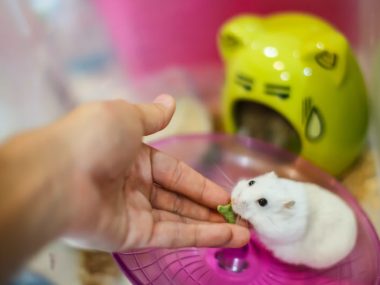Hamsters are naturally clean little creatures that spend a lot of time grooming. It is normal to want to help if you notice that your pet has missed a spot, but bathing them in water is not a good idea. However, there are plenty of alternatives to keep your pet hamster feeling (and smelling!) fresh and clean without stressing it.
Bathing a hamster is not recommended unless it is an emergency and there is no alternative. Occasional spot cleaning may be necessary, especially around its bottom, but dipping a hamster in water can prove fatal. Providing a sand bath is an excellent way to help your hamster clean itself.
Let’s find out how to safely keep your pet clean without getting it wet and stressing it out.
Table of Contents
10 Safe Cleaning Tips For Your Hamster
Hamsters are adorable pets. Although they are rodents, they are extremely fragile, and unlike rats, these tiny fluffballs originate from pretty specific habitats. Wild hamsters live in dry regions like sand dunes and on the edge of deserts, so as you can imagine, they never adapted to taking long relaxing baths with soap and water.
But just because your hamster shouldn’t be washed in water doesn’t mean it won’t love to bath – these cute creatures just do things a little differently! Hamsters absolutely love bathing in sand. Providing a sand bath offers environmental stimulation and will go a long way in your hamster being able to keep itself clean.
A small amount of poop or urine may occasionally get caked onto your hamster’s bottom, and of course, you will want to clean it off before you handle it. As hammies age, they may also need a little more help to groom themselves.
When handling your hamster, keep in mind that they are sensitive creatures that are easily stressed out. Stress and pneumonia are two of the top causes of hamster mortality, and of course, bathing a hamster in water may very well be a combination of both.
Keeping your hamster clean isn’t difficult as long as you remember these ten golden rules of hamster hygiene.
1. Don’t Bathe Your Hamster Unless Instructed By A Vet
Unless it is an emergency and your hamster has somehow got covered in a toxic substance, bathing it with soap and water should never be considered. Even if it has fleas or mites, do not consider washing it. The risks of your pet dying from cold or stress is simply too high.
If you suspect your hamster has fleas, read this article to learn how to treat them effectively.
2. Provide A Sand Bath For Your Hamster
Providing a sand bath for your hammie is the best way to keep it clean. It will love the sand and feel right at home digging and letting the granules absorb any dirt and moisture trapped on its fur.
An added bonus for the hamster owner is that your pet will be better equipped to clean itself, so you probably won’t have to do a thing except ensure that the sand remains hygienically clean.

Never use any type of fine dust or powder which could cause eye or lung irritation. Non-toxic, granular sand is safe to use for your hamster so long as it is clean. Kiddies’ play sand or reptile sand is perfect.
3. Clean The Cage, Not The Hamster
A hamster can only be as clean as the environment it is living in. If your hamster is starting to smell a little iffy, start by cleaning the cage. Provide new bedding and ensure that there are no hidden food stashes anywhere that may be going off. Click here to learn how to keep your hamster’s cage spotlessly hygienic.
Hamsters are naturally clean little creatures, so once you’ve cleaned the cage, if things don’t improve, check that there isn’t some other health issue causing the problem. A smelly hammie may be ill, or an incorrect diet might be causing the issue. Check with a veterinarian if your hamster is having trouble keeping itself clean.
4. Use A Soft Toothbrush To Groom Your Hamster
Grooming your hamster is part of the fun of owning one of these little pets. Use a soft, dry toothbrush to gently brush your hamster. This will also allow you to check it for any other health issues. Check its bottom for any clumps of poop or urine that may be soaked into its fur.
If you have a sand bath available, you can sprinkle some sand over its fur and gently brush it through. Only brush in the direction of the coat and stop immediately if your hammie isn’t enjoying the activity.
5. Spot Clean Dirty Bits
Everyone has hard-to-reach places, and that includes your hamster. This is particularly true of long-haired varieties, which may struggle clean all the bits of their fur coats. To learn more about caring for a long-haired hamster, click here.
If your hamster has some dirt caked onto its bottom, you can use a pet-safe wet wipe or damp washcloth to wipe it gently.
6. Snip Off Clumps Of Dirt
If your hamster has something stuck on a spot on the surface of its fur, it is often a better option to carefully snip off the clump than try to scrub it clean. Hamsters and water baths do not mix, so if your hammie does have a spot of gum or poop matted into its fur, use a blunt-nosed scissor and gently snip the clump away.
This method will only work for small clumps of surface dirt. Take extreme care not to cut the hamster.
7. Never Get Water On Your Hamsters Face and Ears
If you do need to emergency bath your hamster, be extremely careful not to get water near its ears and face. Besides terrifying the animal, water may get into its ears or nose and cause problems that will be extremely difficult to treat later.
8. When Using Water, Keep It Warm And Shallow
Don’t use a bathtub or basin if you need to bathe your hamster. Here’s what you must do:
- Use a small container, like a Tupperware, that has high sides.
- Only add a shallow level of water – the water must not cover its shoulders. Support the hammie’s front section at all times. Hold it securely, so it feels safe, but gently, so it doesn’t panic.
- Water must be lukewarm – not hot or cold.
- The room must be warm and free of drafts.
- Work as quickly as possible – bathing is not something a hamster will enjoy and should only be a last resort in a sticky situation.
9. Only Use Mild Shampoo
Remember that when you are finished bathing your hamster, it will continue to groom. That means it will be licking its fur. Use a very mild hamster-friendly shampoo or a drop of baby shampoo. Never use adult human shampoo or regular soap.
10. Dry The Hamster Completely
If your hamster did get wet during the cleaning process, even if it was just wiping with a damp cloth, it must be allowed to get completely dry before returning it to its cage. A damp hamster will quickly get cold, which can quickly become fatal.

Frequently Asked Questions
What Is The Best Way To Clean A Hamster?
The best method to clean a hamster is to provide a sand bath and let it clean itself. You can assist your hamster by spot cleaning dirty bits when necessary by using a pet-safe wet wipe or damp cloth.
If your hamster has long hair and a lot of feces and urine regularly gets soaked into its rear end fur, carefully trimming some of the fluff around that area is a good option.
Do Hamsters Need A Sand Bath?
While most hamster cage setups don’t include a sand bath, they do appreciate it. Rolling and playing in sand mimic a natural environment, and the sand absorbs some of the oil secretions from their skin.
Can Hamsters Shower With Water?
A hamster should never be showered or soaked with water. They are sensitive creatures that originate from desert regions. Showering a hamster is likely to result in death from stress or cold. The best way to keep a hamster clean is to keep the cage clean, provide a sand bath and let the hamster bathe itself.
References:
https://www.petmd.com/exotic/care/evr_ex_hm_how-to-give-your-hamster-a-bath
https://animals.mom.com/use-clean-hamsters-fur-1031.html
https://animals.mom.com/give-teddy-bear-hamster-bath-1011.html






